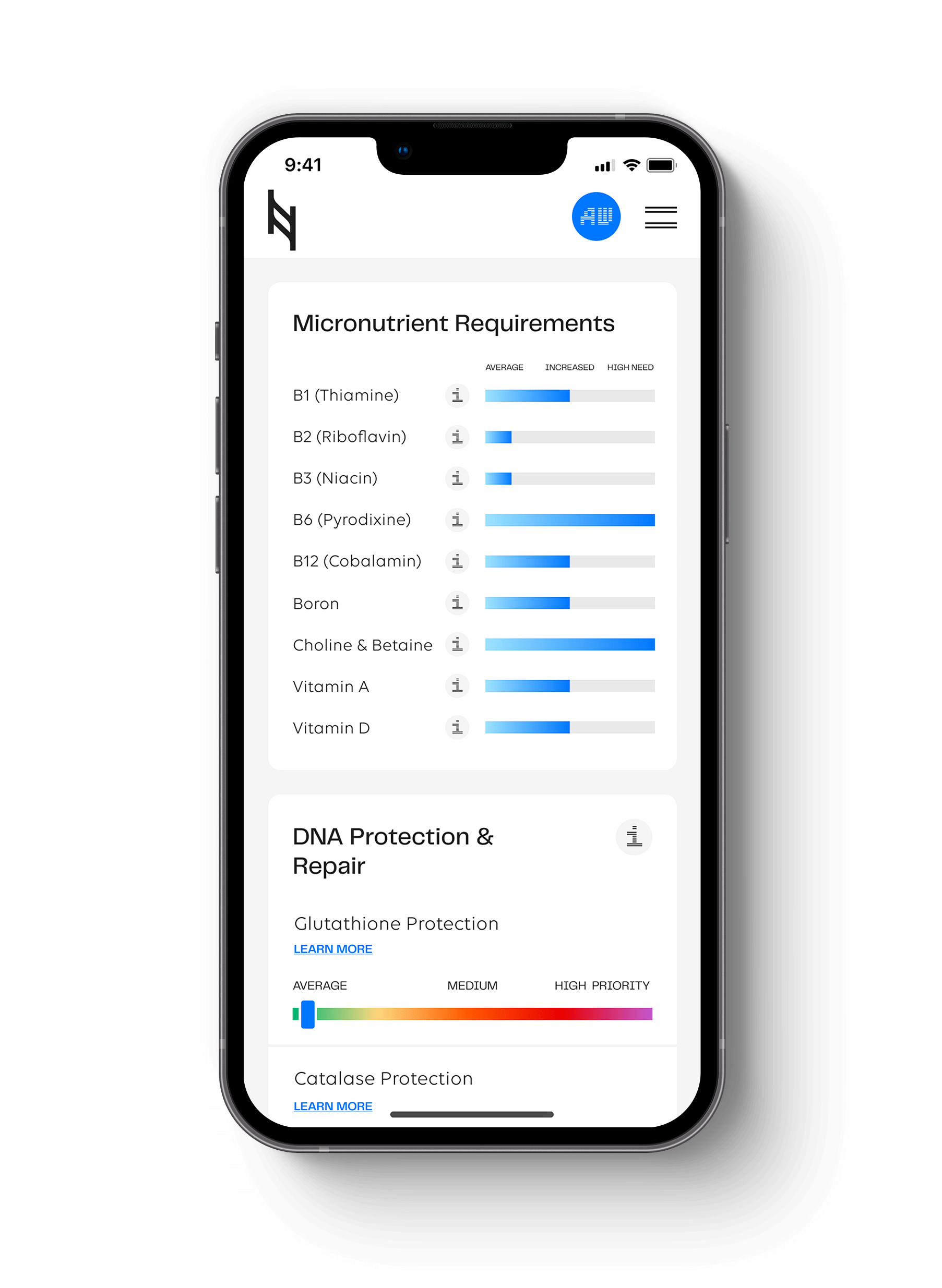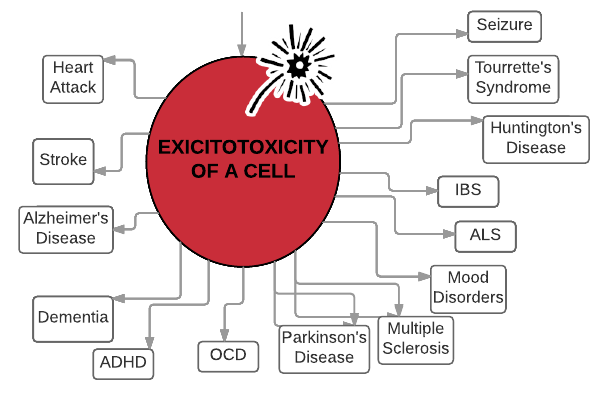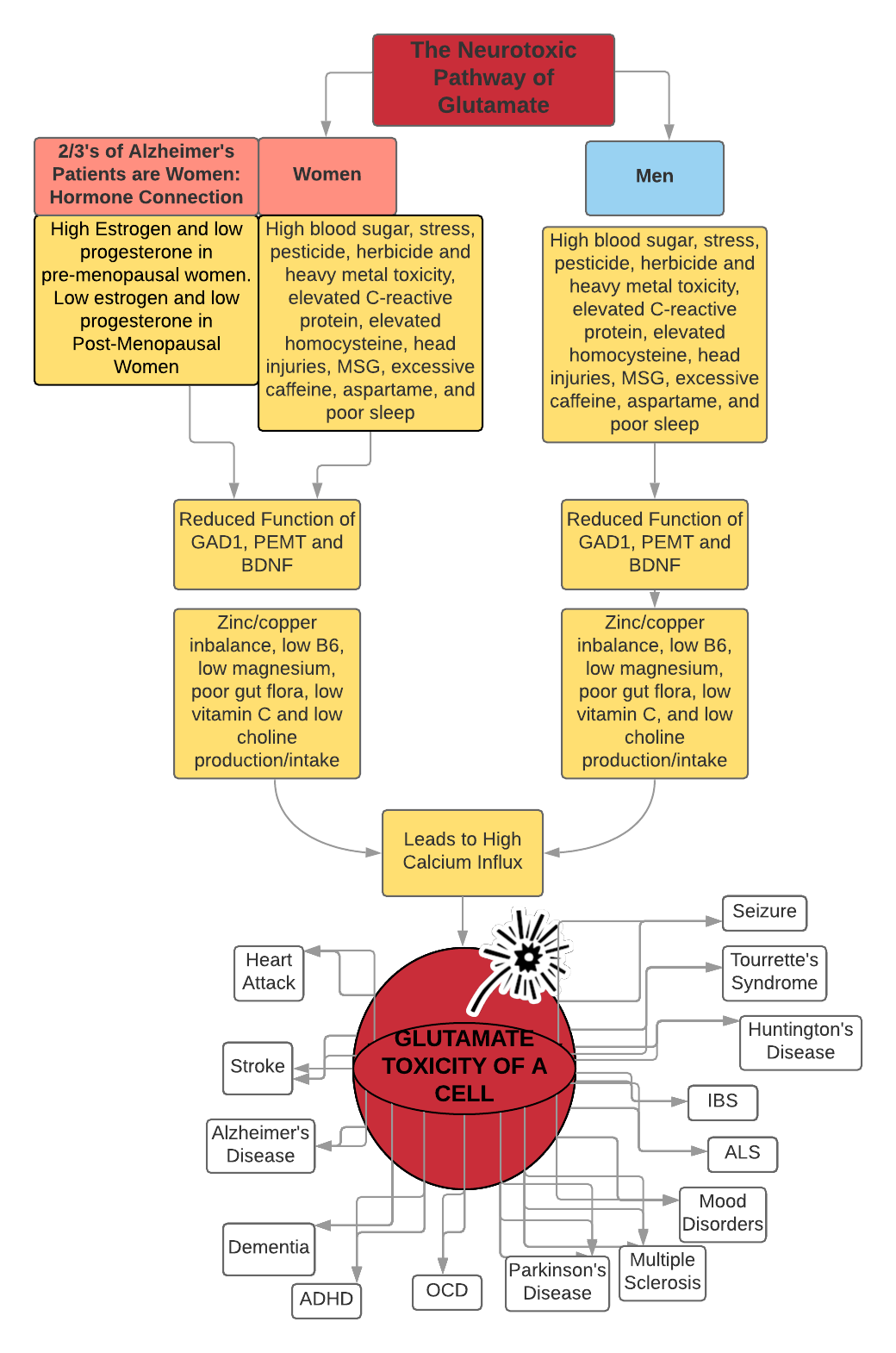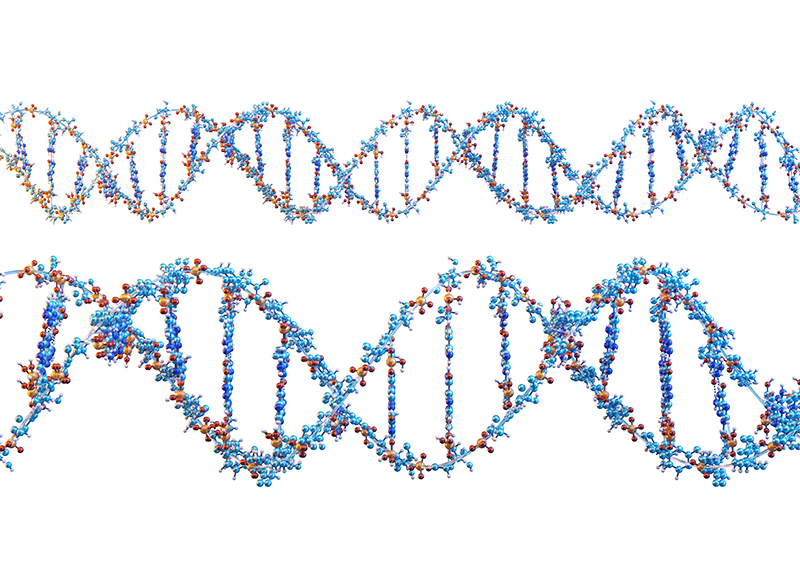Glutamate is an excitatory neurotransmitter, helping focus, cognitive function, and productivity. GABA is the brake, providing a calming respite from glutamate. When there is an imbalance of glutamate being too high, it becomes neurotoxic, whereas glutamate levels that are too low can cause depression.
The Racing Mind: Blame Glutamate
If your mind is racing at night and it keeps you from sleeping or you have had too much coffee, you have experienced high glutamate, high dopamine, and low GABA. The reason that sugar and caffeine addiction is so high for many people is due to the excitatory feeling of dopamine and glutamate, and at healthy levels, it can increase learning, cognition, and memory (think coffee while working or studying).
However, glutamate levels that are too high with low amounts of GABA excitatory to cells, leading to a host of digestive and neurodegenerative disorders. As you will see in the chart below, there is a pattern formed with glutamate neurotoxicity. This can also be seen in families where certain disorders manifest differently in each family member, but they share a glutamate toxicity link.
The Genetic Connection to Glutamate Levels
The neurotransmitter section of the Nutrition Genome Report looks at the GAD1, BDNF gene and other genes connected to probiotics, B6, B2, taurine, magnesium, lithium, choline, vitamin C, zinc, vitamin D and progesterone (for women) for glutamate levels.
The GAD1 gene is connected to the conversion of excess glutamate to GABA, whereas BDNF works as a glutamate modulator. People who have numerous gene variants in GAD1 and other genes may have a slower conversion of glutamate to GABA, and variants in BDNF may lower BDNF and disrupt the ability to modulate glutamate levels. Therefore, these individuals may be more susceptible to the neurodegenerative damage from excess glutamate depending on other glutamate related genes.
Vitamin B6 and magnesium help the conversion of glutamate to GABA, and genes and/or epigenetic factors like medications, stress, diet, and environment will increase the requirements for these two nutrients.
Having low BDNF levels can affect mood, head injury recovery, memory, and blood sugar levels. From a dietary standpoint, DHA, lithium, choline, and the probiotic Bifidobacterium longum all improve BDNF levels. Endurance exercise – especially in the heat – is one of the best ways to increase BDNF levels while burning excess glutamate from the brain as fuel for the muscles.
Where is Glutamate Found in the Body?
There are numerous glutamate receptors in all organs and tissues. The entire GI tract, from the esophagus to the colon, has numerous glutamate receptors. The entire electrical conducting system of the heart is replete with glutamate receptors. The lungs, the ovaries, all the reproductive systems and sperm itself, adrenal glands, bones, and even calcification are all controlled by glutamate receptors. They act and operate exactly like the glutamate receptors in the brain. This is why glutamate has been linked to so many neurodegenerative disorders.
Is Glutamate a Neurotoxin? See the Neurotoxic Pathway of Glutamate
The diagram below shows you how women and men can become more susceptible to elevated glutamate levels and what you can do to lower it to help reduce the probability of neurodegenerative disease. As you will see for women, estrogen and progesterone levels play a major role in glutamate and GABA levels, with progesterone helping produce GABA and help buffer the excitatory effect on glutamate.
Sources
- Tourette’s Syndrome: http://www.ncbi.nlm.nih.gov/pubmed/20625961
- ADHD and OCD: http://www.ncbi.nlm.nih.gov/pmc/articles/PMC4425334/
- ALS and Huntington’s Disease: http://www.ncbi.nlm.nih.gov/pmc/articles/PMC2842587/
- Heart Attack/Stroke: http://www.anaturalcure.com/stroke-heart-failure-blaylock-july-09-2/
- Seizures: http://www.ncbi.nlm.nih.gov/pubmed/7970002
- Parkinson’s: http://www.ncbi.nlm.nih.gov/pubmed/8732541
- Alzheimer’s Disease: http://www.ncbi.nlm.nih.gov/pmc/articles/PMC3481041/
- Estrogen, Progesterone and Glutamate: http://www.ncbi.nlm.nih.gov/pubmed/20980684
- Low Estrogen and Alzheimer’s Disease: http://www.ncbi.nlm.nih.gov/pmc/articles/PMC3058507/
- Multiple Sclerosis: https://www.ucsf.edu/news/2009/04/4227/glutamate-identified-predictor-disease- progression-multiple-sclerosis
- ADHD: http://www.ncbi.nlm.nih.gov/pmc/articles/PMC3966039/
- Hypertension. http://www.ncbi.nlm.nih.gov/pmc/articles/PMC3628354/
- Exercise and glutamate: http://www.ncbi.nlm.nih.gov/pubmed/23377269
- Iron and copper high in air pollution: http://www.ncbi.nlm.nih.gov/pmc/articles/PMC3628354/
Hit your health goals faster
We'll help you remove the guesswork
Experience the most advanced nutrigenomic test available, covering 100 clinically relevant genes for a "whole body" analysis. Take control of your health today.
$359























